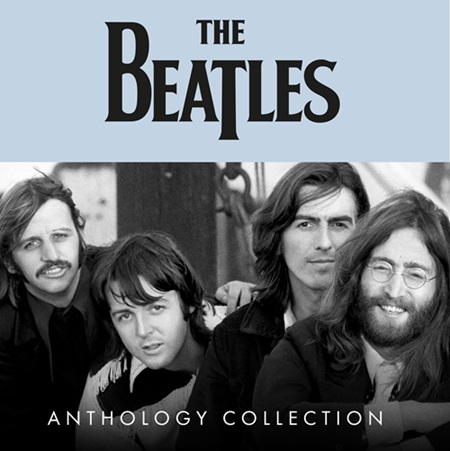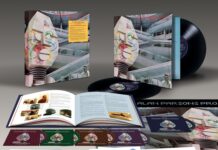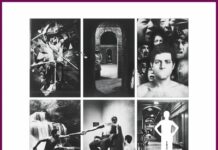There’s little argument that The Beatles Anthology documentary released in 1995 is the definitive story of The Beatles, the greatest rock and roll band of all time. It also raised the rock doc bar incredibly high for all that followed. Along with the multi-part television series and companion book came three double CDs filled with highly sought-out (and bootlegged) early takes, alternate takes, conversation and various other unreleased Beatle tidbits officially and properly issued on Apple Records.
The three surviving Beatles — Paul McCartney, George Harrison, and Ringo Starr — were all in on sharing their memories, old footage, music, and two “new” songs conjured up from John Lennon demos. As with many things Beatles in this day and age, celebrating the 30th anniversary of The Beatles Anthology means more untapped treasures from the vault and a couple AI-driven enhancements for a new generation. And undoubtedly, the droves of the faithful from previous generations as well.
The expanded 12 LP and eight CD Anthology Collection sets include the original three volumes, plus a new fourth volume. The first three (Anthology 1, 2, 3) from 1995-96, which include the same track lists and liner notes, have been remastered by Giles Martin. With many of the Anthology recordings in development and often not up to scratch in the first place (which is why they didn’t make it to the original albums), it’s difficult to say if remastering them is any improvement. Consult tour local audiophile for guidance there.
That, of course, doesn’t delineate from the purity and value of what’s here. Where else are you going to get unreleased gems like George Harrison’s “Not Guilty,” John Lennon’s “What’s The New Mary Jane,” Paul McCartney’s “Junk,” and the “Los Paranoias” impromptu jam (among many others).
Anthology 1, which begins with the then “new” track “Free As A Bird,” mostly comprises those key early songs that helped transform Lennon, McCartney, Harrison, and later Ringo Starr into the tight little band they became. Mixing originals like “In Spite Of All The Danger,” “You’ll Be Mine” and “Hello Little Girl” with covers of Buddy Holly’s “That’ll Be The Day” and the traditional “My Bonnie” allowed the band to metamorphose into capable songwriters and musicians. At the same time, their unique sense of humor started to crystallize around the fore.
Pete Best receives credit for those early cuts (for which he was reportedly well compensated), but once Starr climbed aboard, the Beatles were suddenly on a fast track to worldwide domination. Early takes of “Can’t Buy Me Love,” “Hard Day’s Night” and “I’ll Be Back” are prime examples of how the band and producer George Martin would take the basic framework of a song or idea, then sculpt and build it, introducing different parts, instruments, voices, orchestrations, textures, beats, effects, and their own imaginations into the mix. That approach was at the heart of their process.
Anthology 2 begins with the second then “new” song “Real Love” and picks up from where Anthology 1 leaves off. At this stage, with Abbey Road becoming their “creative workshop,” the Beatles began making some of their greatest strides as music and taste makers. Take 5 of “You’ve Got To Hide Your Love Away” is Lennon as pure and raw as can be. Two originals —“If You’ve Got Trouble” (with Starr on lead vocals) and “That Means A Lot” — that appear here were meant for the Help soundtrack, but didn’t make the grade (they were starting to get choosey). The latter was recorded by American singer to P.J. Proby, managed by Brian Epstein, who we all know represented the Beatles.
Of course, the early mix of “Tomorrow Never Knows,” as much of a lovely treat that it is, may well be outdone by the multiple takes of “Strawberry Fields Forever,” a discourse in musical composition and arrangement if there ever was one. The new stereo mix of “You Know My Name (Look Up The Number)” somehow makes it even stranger, while take 16 of “I Am The Walrus” is stark, yet powerful without the embellishments that turned it into such a lurid and wild piece. If the early take of “Across The Universe” that closes out Anthology 2 doesn’t lull you into a trance, nothing ever will.
Much of what appears on Anthology 3 has found its way to expanded versions of The White Album, Abbey Road, and Let It Be. “A Beginning,” an unissued George Martin orchestral piece intended to precede Starr’s “Don’t Pass Me By” on The White Album, sweetens the set from the get-go. Six demos from the fabled Esher sessions would find homes in their final states on The White Album and Abbey Road, with the exception of “Junk,” which McCartney unintentionally saved for a future Wings release.
The aforementioned “Not Guilty,” “What’s The New Mary Jane,” and the “Los Paranoias” jam are slotted in with more demos from The White Album to finish the first half of Anthology 3. The second half zeroes in on the Get Back sessions, as well as Abbey Road. If you watched the three-part Get Back documentary series, you may well have seen, as well as heard, many of these takes. Nevertheless, the loose and funky run-through of “I’ve Got A Feeling” included here could have made the cut if Lennon hadn’t flubbed up the end. If anything, the Anthology Collection shows the world the members of the Beatles were every bit as susceptible to human foil and folly as anyone else.
While it’s nice to hear the demo of “All Things Must Pass” intended for Beatles transformation, you can’t deny George Harrison’s solo rendition reigns supreme. At least the boogie undercurrent going on with the “Old Brown Shoe” demo the guitarist presented wasn’t lost in the stampede. “Because” in a cappella will undoubtedly give you goosebumps, while the remix of “the End,” which brings in more guitar from Lennon, McCartney, and Harrison, undoubtedly brought forth a well of tears in 1996 from many believing that was all they’d ever get from the vaults. We now know that assumption was far from the truth.
Which brings us to the previously unreleased Anthology 4, the one completists, elitists, and assorted aficionados are most curious about. You could say they swept up the floor of what was left over from the original three-volume Anthology, and this is what they came up with. That, of course, would be a gross miscalculation. It does run the gamut, beginning with the second take of “I Saw Her Standing There” right up to “Now And Then,” the third and final “new” Beatles song that appeared on 2023’s The Beatles 1967 – 1970 reissue.
Multiple takes of “This Boy,” “Tell Me Why” and “Every Little Thing” reveal how quickly the Beatles were able to rebound, keeping things convivial and fun as the clock ran on what were then very formal, restrictive recording sessions. The first take of Harrison’s “I Need You” is a true sign of an emerging songwriter within the ranks of two others who’d already found international acclaim.
You’ll struggle to catch your breath after hearing the first take of “In My Life” in all its plaintive innocence. After a few false starts and Lennon’s request for some cokes and cannabis, the group finally snaps together takes 10 and 11 of “Baby, You’re A Rich Man,” which was intended for the Yellow Submarine film but ended up as a B-side. One more take landed it in the can. The BBC rehearsal of “All You Need Is Love” follows and seems to be pretty much where it needed to be for its primetime worldwide television debut. The rolling guitars should have been left in.
The first take of “Good Night” that appears on Anthology 3 is more or less a rehearsal as the arrangement was far from what it became. On Anthology 4, the fifth take is combined with take 10 to create a fuller guitar mix and Lennon, McCartney and Harrison’s backing vocals to Starr’s lead. Obviously, once the orchestra was brought in, Starr was the only Beatle left standing in the final mix.
Hearing Eric Clapton find his mojo on “While My Guitar Gently Weeps” offers that rare peak at another player figuring his way into Beatle universe. Going back to the Get Back documentary series, you may recognize the rehearsal (more of a working out) of “Octopus’s Garden” where Starr plays through the verses and Harrison refines the edges.
As with the isolated strings of “Eleanor Rigby” that appear on Anthology 2, there are orchestral sections featured on Anthology 4. This flavor of ornamentation often taken for granted on the final product is especially poignant on “She’s Leaving Home,” with an arrangement written by Mike Leander at McCartney’s behest instead of George Martin, who was committed elsewhere. Martin did produce the session and conducted the orchestra, with the first take here a keeper used in the final mix. The strings on take 29 of “Something” cannot overstate the breadth they add to what is arguably one of George Harrison’s greatest songs.
What many might find most appealing about Anthology 4 are the new mixes of “Free As A Bird” and “Real Love.” Using a new de-mixed technology derived from AI, Lennon’s vocals are lifted out of the static mire they couldn’t remove in 1995 and sound much more prominent. The guitars on “Free As A Bird” also ring brighter around the verses. After “Now And Then,” the last Beatles song, finishes off the set, you may ponder (aloud or silently): Is there more?
Indeed, for all the revelations the Anthology Collection recordings provide, there’s still a few missing nuggets fans would love to wrap their ears around. The “real” version of the never-released “Carnival Of Light,” which supposedly inspired “Revolution #9,” is on everybody’s wish list. The 27-minute “Helter Skelter” jam from July 18, 1968, is another one the faithful, including renowned Beatles authority Mark Lewisohn, would like to see come out. A 12-minute version (take 2) on Anthology 3, cut down to 4:37, is a mere tease, and a three-minute, second version of take 17 from September 9 that appears on Anthology 4 does little more than elicit a woozy “Mark that Fab” comment from McCartney.
You can also add the 15-minute “Dig It” jam edited down to its 51 seconds on the Let It Be album to the short list of Beatles songs held back from official release anytime soon. For now, contend yourself with 191 tracks, plus three booklets full of photos, the 1996 interviews conducted by Beatles press agent and adviser Derek Taylor, and track notes written by Kevin Howlett. With The Beatles Anthology documentary freshened up and ready to make the 2025 holiday season even more fab, it’s only a matter of time before more artifacts are uncovered and sent to the lab for rebirth.
~ Shawn Perry




















